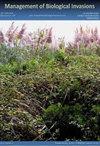Invasive non-native species management under climatic and anthropogenic pressure: application of a modelling framework
IF 1.2
4区 环境科学与生态学
Q3 BIODIVERSITY CONSERVATION
引用次数: 1
Abstract
Mitigation of impacts from already established invasive non-native species (INNS) relies on reducing species abundance and onward spread. However, there is limited understanding regarding the effectiveness of INNS management approaches in the short and long term, in particular in the marine environment. Further, the interplay between management and key population drivers is not well explored. The Pacific oyster Crassostrea gigas Thunberg, 1793, also known as Magallana gigas Thunberg, 1793 , is native to the north-eastern Pacific coast of Asia and has been introduced in the UK for aquaculture purposes, with wild populations now widely established along the South coast. Concern over the potential impact of this species has led to trial of its management, yet clear evidence to support management decisions around this species is still lacking. This study applied a modelling framework, based on differential equations representing C. gigas life stages, to explore the effect of adult oyster population management on population persistence and density, under changing temperatures and external larval recruitment. The outputs highlight that population control may be possible and intuitively population density is negatively correlated with management frequency and effort. However, the exact relationship between population density and management is influenced by spawning and external recruitment. Specifically, outputs indicate that while the effects of climate change could be counterbalanced by an increase in management effort, the impact of external recruitment can only be reduced through management, rather than reversed. The wider application of this framework to inform INNS management decisions is discussed.气候和人为压力下的外来入侵物种管理:建模框架的应用
减轻已经存在的外来入侵物种(INNS)的影响依赖于减少物种丰度和继续扩散。然而,人们对生态系统管理办法在短期和长期的有效性,特别是在海洋环境方面的有效性了解有限。此外,管理和主要人口驱动因素之间的相互作用没有得到很好的探讨。太平洋牡蛎Crassostrea gigas Thunberg, 1793年,也被称为Magallana gigas Thunberg, 1793年,原产于亚洲东北太平洋沿岸,已被引入英国用于水产养殖目的,野生种群现已在南海岸广泛建立。考虑到该物种的潜在影响,已经对其管理进行了试验,但仍然缺乏明确的证据来支持围绕该物种的管理决策。本研究基于代表gigas生命阶段的微分方程建立了一个模型框架,探讨了在温度变化和外部幼虫招募的情况下,成年牡蛎种群管理对种群持久性和密度的影响。产出强调人口控制是可能的,直观地说,人口密度与管理频率和努力负相关。然而,种群密度和管理之间的确切关系受到产卵和外部招募的影响。具体而言,产出表明,虽然增加管理努力可以抵消气候变化的影响,但外部征聘的影响只能通过管理来减少,而不能逆转。讨论了该框架在INNS管理决策中的更广泛应用。
本文章由计算机程序翻译,如有差异,请以英文原文为准。
求助全文
约1分钟内获得全文
求助全文
来源期刊

Management of Biological Invasions
Agricultural and Biological Sciences-Ecology, Evolution, Behavior and Systematics
CiteScore
3.40
自引率
6.70%
发文量
21
审稿时长
16 weeks
期刊介绍:
Management of Biological Invasions, established in 2010 by Dr. Elias Dana, is an open access, peer-reviewed international journal focusing on applied research in biological invasions in aquatic and terrestrial ecosystems from around the world. This journal is devoted to bridging the gap between scientific research and the use of science in decision-making, regulation and management in the area of invasive species introduction and biodiversity conservation.
Managing biological invasions is a crisis science, with Management of Biological Invasions aiming to provide insights to the issues, to document new forms of detection, measurements and analysis, and to document tangible solutions to this problem.
In addition to original research on applied issues, Management of Biological Invasions publishes technical reports on new management technologies of invasive species and also the proceedings of relevant international meetings. As a platform to encourage informed discussion on matters of national and international importance, we publish viewpoint papers that highlight emerging issues, showcase initiatives, and present opinions of leading researchers.
 求助内容:
求助内容: 应助结果提醒方式:
应助结果提醒方式:


